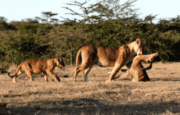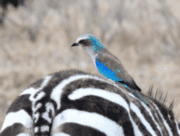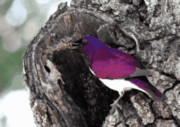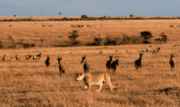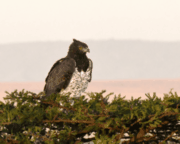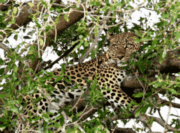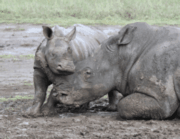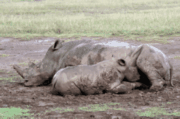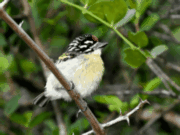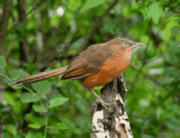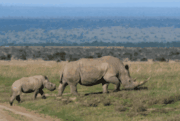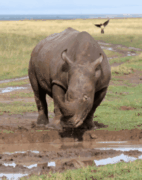|
Mike Mockler Kenya November 2018 |
THE MARA CONSERVANCIES It was clear that the rains were late when we arrived: dry conditions were widespread throughout the Mara. The heat and dust would be a nuisance at times but the game-viewing would prove to be excellent throughout the tour. Nearly eight months earlier, I had spent 6 nights in the Naboisho conservancy when it was very green. Now that felt a distant memory. Over many hours we had watched Selenkei, an inexperienced cheetah mother with four delightful cubs that had only just been brought out from their birth-place. However, the future had looked bleak for them as the cubs frequently became separated from their mother and nearby were many lions, hyenas and jackals, all of which would kill small cheetah cubs. So, you can imagine my delight when we found Selenkei with all four cubs alive and well over 7 months on from my last visit. They were resting in the shade of a balanites tree, looking nervous after an encounter with Dongo, a magnificent pride male lion. We watched Selenkei preparing for a hunt. She caught a young topi, which seemed to be lost, having become separated from its mother. The cubs also chased a black-tailed scrub hare but with no success. We were to see Selenkei hunting again two days later when she took down a female impala. Only a few minutes after the kill was made, a hyena appeared, intent on stealing the cheetah's kill. Amazingly, one of the cubs chased the hyena away single-handed. However, when a lioness approached, all five cheetahs moved away and the lioness was able to seize the carcass for herself with no opposition. We also saw another cheetah mother with three cubs that were significantly smaller than Selenkei's. We found her only moments after she made a kill, an adult male impala, and just as a hyena was stealing the carcass. As more hyenas arrived, they caused mayhem and the cheetah family could only watch helplessly from the sidelines. Soon the drama was ratcheted up by a large number of vultures dropping in, one of which was the now very rare white-headed vulture. When the cheetahs departed the scene, we followed them until they flopped down in some shade. A most unusual sighting involved an adult male impala with part of another male's horn lodged in his shoulder. Almost certainly this was the result of a territorial fight, but the impala concerned seemed unaffected by the horn dangling from his flesh. There were plenty of birds, mostly resident species including various colourful starlings, woodpeckers and hornbills plus silverbird, buff-bellied warbler, white-headed buffalo weaver and pygmy falcon. Other birds seen were water thick-knees (water dikkops), with two tiny chicks, a marabou stork having great difficulty swallowing an enormous catfish and a group of ground hornbills which comprised an adult male, a sub-adult and a chick. Two of them were carrying lizards and one a snake. Migrants included abundant barn swallows and northern wheatears along with scarcer species such as pied wheatear and Isabelline shrike. We found the leopard mother known as Tito with her two cubs. After watching her male cub make a complete hash of stalking birds, we located Tito lying with her female cub. We spent a long time with mother and daughter as they showed mutual affection in a very "touchy-feely" way, by turns heart-warming and amusing. We carried on watching and taking photos until the light had almost gone and we had to hurry back to camp. This was one of the major highlights of the trip. At each of the locations we visited, we saw many lions, often with cubs. In one intriguing episode, a herd of buffalo had discovered a lioness with new-born cubs in a deep, dry gully. From above we could see the mother and cubs but the buffalos had a restricted view and were relying more on their sense of smell. They would kill the lion cubs if they could get to them but they were unsure how many lions were in the gully. They played safe and eventually wandered off. We also observed some side-striped jackals, including two pups, at their den. This a nocturnal species, not a common sighting. Until now we had seen very few elephants but we made up for this when we reached Mara North conservancy where we saw numerous groups, including many breeding herds with small calves. In fact, we saw elephants on every game-drive here and, encouragingly, they were invariably calm and relaxed. There were always plenty of birds in Mara North, saddlebilled stork, male paradise flycatcher and fish eagles among them. On one occasion, we enjoyed a little cameo: a lilac-breasted roller was perching on the backs of some zebras and hawking for insects stirred up by their hooves. There was also a pair of violet-backed starlings that were starting to build their nest in a tree-hole - until three females interrupted them. Other birds seen included rufous-bellied heron, intermediate egret, glossy ibis, African spoonbill and pygmy kingfisher. The big highlight came when our Masai guide brilliantly spotted a leopard hidden under a bush. It turned out to be Nalangu and we stayed to watch her setting off to hunt as the light faded. Nalangu is the grand-daughter of Half-tail and the daughter of Shadow, both former stars of the BBC programme, Big Cat Diary. Shadow, was the name invented by the BBC because they thought their viewers would have problems with her Swahili name, Zawadi, which means "gift" Zawadi gave birth to Nalangu in Leopard Gorge in 2011. On one morning drive, we found two male cheetahs that had just killed a young topi. They devoured most of it and were pretty full when a hyena arrived on the scene. They gave the carcass up quite willingly. On our final afternoon in the Mara, we found Nalangu again elegantly draped in a tree with a young impala kill nearby, a satisfying end to our time in the Mara conservancies.
Laikipia Extension While having lunch at camp, we were able to enjoy watching a herd of elephants at the waterhole plus, later, a huge herd of buffalo. There was also a very confiding bull eland on the shoreline. We saw plenty of rhinos, both black and white. One white rhino we met was a very big bull with a reputation for chasing vehicles - unsurprisingly, we treated him with considerable caution. Our big rhino highlight came when heavy rain started. An endearing little white rhino calf that had been sleeping alongside its mother, suddenly became excited and started frolicking in the mud, slipping, sliding, splashing and making a series of high-pitched calls. It tried to clamber over the mother but gave up as it kept slithering off her great bulk. Finally, it settled down to suckle. Magical! Later that morning, we saw another group of four white rhinos, including an older calf and a big male and two black rhinos, a mother with her calf which was coated in mud. Other sightings included reticulated giraffes "necking", some groups of the very localised Jackson's hartebeest, one with a small calf, steenboks and four male lions with two females, including one mating pair, all typically inactive, some extreme hyena warfare and a rare Patas monkey. Some members of the group went on a night drive which produced aardvark, lesser bushbaby, white-tailed mongoose and scrub hares. Birdwatching was excellent, no doubt largely as a result of the recent rain. The grounds of the camp were full of different bird calls: sulphur-breasted bush-shrike, grey-headed bush-shrike, rufous chatterer, brown babblers, red-fronted tinkerbird and white-browed robin-chat. The rains had triggered off breeding activity and numerous species were already nesting, among them scarlet-chested sunbird, marico sunbird, red-headed weaver and vitelline masked weaver. On the final day, we had good views of two white rhinos and a large herd of elephants with calves drinking on our way to the airstrip. While we waited for the plane to arrive, our guides had to keep chasing zebras off the runway. It was an entertaining end to a hugely enjoyable tour.
|
|
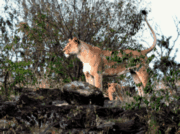
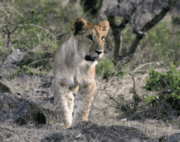
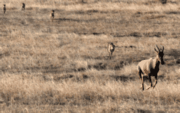

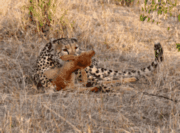
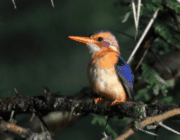
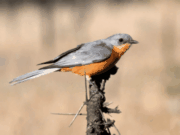
.gif)
